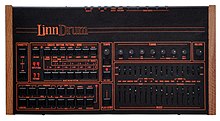Art Wood, Linndrum, Won't You Do Me Baby
| LinnDrum | |
|---|---|
 LinnDrum digital drum automobile | |
| Manufacturer | Linn Electronics |
| Dates | 1982–1985 |
| Toll | US $2,995 |
| Technical specifications | |
| Polyphony | polyphonic 12 voices |
| Timbrality | multitimbral 15 voices |
| Synthesis type | eight-bit digital samples, 28–35 kHz |
| Storage retention | 56 user patterns, 42 preset drum patterns, 49 songs |
| Effects | Private level and pan for all sounds, tuning for snare, tom and conga simply |
| Input/output | |
| Keyboard | 15 hard plastic "pads" |
| External control | DIN sync (pre-MIDI), third-party MIDI Retrofit Kit, trigger inputs x5 |
The LinnDrum (often incorrectly[1] referred to as the LM-2) is a pulsate machine manufactured past Linn Electronics betwixt 1982 and 1985. About five,000 units were sold.[2] [three]
Its loftier-quality samples, flexibility and affordability fabricated the LinnDrum popular; information technology sold far more than units than its predecessor (the LM-1) and its successor (the Linn 9000) combined.[3] Roger Linn re-used the moniker on the LinnDrum Midistudio and the Roger Linn Designs' LinnDrum Two. The LinnDrum was used on many recordings throughout the 1980s, including international hits such as Frankie Goes to Hollywood'due south "Relax", a-Ha'southward "Take On Me", Harold Faltermeyer'southward "Axel F", Billy Idol's "Eyes Without a Face", Deniece Williams'south "Let's Hear It for the Boy", Paul Davis'south "'65 Dear Affair" and Madonna's "Lucky Star".
When Linn Electronics closed in 1986, Forat Electronics purchased its assets[4] and offered service, sounds and modifications for the LinnDrum.[5] The LinnDrum was pre-MIDI, using a DIN sync interface,[6] merely MIDI Retrofit Kits were offered by JL Cooper[7] and are currently offered by Forat Electronics.[5]
Features [edit]
The LinnDrum has fifteen 8-flake 28 kHz ~ 35 kHz digitally sampled drum sounds: bass drum, snare, side-stick snare, hi-hat, crash cymbal, ride cymbal, three tom-toms, cabasa, tambourine, high and low congas, cowbell, and hand-claps. Like the LM-1, it provided a sequencer for programming rhythm patterns, a born mixer and individual output jacks for each sound.
The LinnDrum cost $ii,000 less than the LM-ane, but improved upon the LM-one in many ways, including the addition of crash and ride cymbal samples, v external trigger inputs, and the choice to replace the original sounds with new sounds via EPROM chips. Whereas the LM-ane allows every sound to exist individually tuned yet, the LinnDrum allows only the snare and rimshot tin can exist tuned together, while the tom and conga samples can be tuned separately. The LinnDrum hi-hats permit a disuse adjustment, allowing for more versatility. For LinnDrum users that desire more flexibility, a tertiary-party modification allows more sounds to be tuned individually, equally with the LM-one.
History [edit]
The LinnDrum was designed past Roger Linn. According to Linn, his company started out as a one-production company, depending on the success of the LM-1. He was inspired to design a successor after a NAMM show where he met Roland Corporation founder Ikutaro Kakehashi, who encouraged him to "motility beyond existence a one-product company then that a slowdown of my one product does not take the company down".[8]
Drum samples [edit]
The LinnDrum sounds were reportedly sampled from real drums played specifically for the machine by Los Angeles drummer Fine art Wood, a friend of Linn, who played with Linn and musicians including Peter Frampton, Gary Wright, Cher, Tina Turner, Bette Midler and James Chocolate-brown.[ii] Notwithstanding, "The LM-1 was the first pulsate motorcar to employ samples of a real drum kit, Roger Linn confirms that it was indeed Art Wood session drummer that played the majority of the sounds that he used.[9] To further add together to the mystery, an entry in the online museum of the Roger Linn Design company credits L.A. session drummer Art Wood with near of the samples."[2] While the Roger Linn Designs By Products Museum page credits Art Wood for "most" of the LM-1 sounds, in that location is no credit for the drummer who played the sounds for the LinnDrum. In the moving-picture show Sound City, session drummer Jim Keltner takes credit for the drum samples.
References [edit]
- ^ French, Josh (fifteen March 2019). "An introduction to the Linn LM-1 and 10 records it helped ascertain". The Vinyl Factory . Retrieved 20 June 2021.
The models also had some teething issues, but those were addressed with 2 revisions of the LM-1, before a cheaper successor, the LinnDrum – not the LM-2, as it is commonly mis-titled – was introduced in 1982.
- ^ a b c "Linn Electronics LinnDrum". Vintage Synth Explorer . Retrieved 6 March 2015.
- ^ a b "Past Products Museum". Roger Linn Design. Archived from the original on 6 February 2015. Retrieved vii March 2015.
- ^ "Forat History". Forat Electronics.
- ^ a b "The LinnDrum". Forat Electronics.
- ^ Dormon, Bob (26 Baronial 2013). "Happy birthday MIDI 1.0: Slave to the rhythm". The Annals.
- ^ Matrix (29 June 2010). "LINN LM-2 Drum Machine with JL Cooper Midi Mod & Instructions". Matrixsynth . Retrieved 23 April 2015.
- ^ Linn, Roger. "In Memory of Ikutaro Kakehashi". Roger Linn Design. Archived from the original on two May 2017.
- ^ McNamee, David (22 June 2009). "Hey, what's that sound: Linn LM-1 Drum Computer and the Oberheim DMX". The Guardian.
External links [edit]
- Roger Linn Design
Source: https://en.wikipedia.org/wiki/LinnDrum
0 Response to "Art Wood, Linndrum, Won't You Do Me Baby"
Enregistrer un commentaire